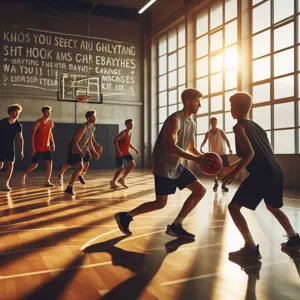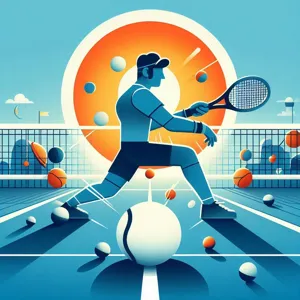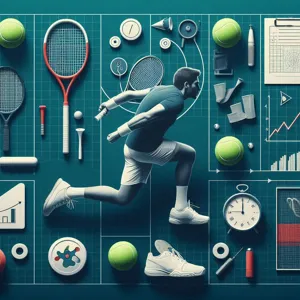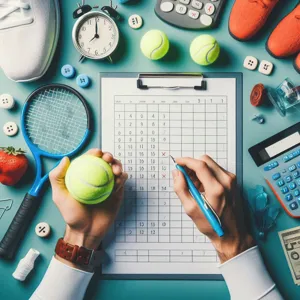As the basketball season heats up, the excitement of each game can be both exhilarating and overwhelming.
Whether you’re a player striving to improve your skills, a coach seeking to inspire your team, or a fan passionate about your favorite squad, staying motivated is key to achieving your goals on and off the court. In a sport that demands discipline, resilience, and teamwork, it’s essential to harness that motivation to push through the tough days and celebrate the victories, big and small. In this blog post, we’ll explore top strategies to keep your spirits high and your focus sharp throughout the season. From setting achievable milestones and building a supportive community to embracing the challenges that come your way, we’ll equip you with the tools to slam dunk your goals and make this basketball season your most rewarding yet!
1. Understanding the Importance of Goal Setting in Basketball

Understanding the Importance of Goal Setting in Basketball
Goal setting isn’t just a buzzword in sports; it’s a fundamental pillar that can determine the trajectory of your basketball journey. Whether you’re a seasoned player or just lacing up your sneakers for the first time, having clear, defined goals gives purpose to your training and performance. Goals serve as a roadmap, guiding your efforts and helping you stay focused amidst the hustle and bustle of a demanding season.
When you set specific, measurable, achievable, relevant, and time-bound (SMART) goals, you create a structure that allows you to track your progress and celebrate your achievements. For instance, instead of simply aiming to “improve your shooting,” a more effective goal might be to “increase your free throw percentage from 70% to 80% by the end of the season.” This clarity not only enhances your motivation but also fosters a sense of accountability.
Moreover, goal setting enables you to break down larger ambitions into smaller, manageable milestones. As you achieve each one—whether it’s perfecting your dribbling skills, improving your defense, or increasing your endurance—you build momentum and confidence. This positive reinforcement can be particularly crucial during tough times, such as after a loss or during a challenging practice.
Additionally, sharing your goals with teammates or coaches can create a supportive environment that encourages collective growth. By holding each other accountable and cheering on each other’s progress, you cultivate a culture of motivation and perseverance within your team.
Remember, goal setting in basketball isn’t just about individual aspirations; it’s about fostering a mindset that embraces challenges, learns from failures, and continuously strives for excellence. With well-defined goals, you’ll find yourself not only improving as a player but also enjoying the journey much more. So as the season kicks off, take the time to reflect on what you want to achieve and lay down the groundwork for a successful and fulfilling basketball experience!
2. Defining Your Goals: Short-Term vs. Long-Term
Defining your goals is a crucial step in maintaining motivation throughout the basketball season, and understanding the distinction between short-term and long-term goals can set you up for success both on and off the court.
Short-term goals are those achievable milestones that you can focus on week by week or even day by day. They might include improving your free throw percentage, perfecting a specific dribbling technique, or increasing your shooting accuracy during practice. By setting these smaller, attainable objectives, you create opportunities for quick wins that can boost your confidence and keep your enthusiasm high. Celebrating these victories, no matter how small, reinforces your commitment and makes the journey feel rewarding.
On the other hand, long-term goals provide a broader vision for your basketball career and personal development. These could include aspirations like earning a spot on the varsity team, securing a scholarship, or even playing at the collegiate level. Long-term goals often require patience and persistence, as they may take months or even years to achieve. To stay motivated, it’s essential to regularly revisit these long-term ambitions, breaking them down into actionable steps that align with your short-term objectives.
For instance, if your long-term goal is to play at the collegiate level, your short-term goals might include attending skill camps, improving your physical fitness, or networking with coaches. By linking short-term achievements to your long-term aspirations, you create a roadmap that not only keeps you focused but also fuels your passion for the game.
In summary, defining your goals—both short-term and long-term—creates a structured approach to your basketball journey. It allows you to maintain motivation by providing a clear vision and measurable progress, ensuring that each practice and game brings you one step closer to your ultimate aspirations. Keep pushing yourself, and remember that every effort counts in your pursuit of excellence on the court!
3. Creating a Game Plan: Breaking Down Your Goals

Creating a game plan is essential for staying motivated throughout the basketball season, and just like any successful team, you need a strategy that can guide you toward your objectives. Start by breaking down your goals into smaller, manageable steps—this not only makes them less daunting but also allows you to celebrate progress along the way.
Begin by setting specific targets for different aspects of your game. For instance, if your overarching goal is to improve your shooting percentage, you might break this down into sub-goals, such as practicing free throws three times a week, dedicating time to work on your three-point shooting, and analyzing your shooting form through video review. Each sub-goal becomes a critical play in your overall game plan, contributing to the larger objective of becoming a more skilled player.
Documentation is key. Consider keeping a goal journal where you outline your objectives, track your progress, and note any adjustments needed. This will serve as your playbook, reminding you of the strategies you’ve devised and helping you identify what works best. Additionally, schedule regular check-ins with yourself—perhaps every month—where you can assess your achievements, recalibrate your strategies, and keep your motivation levels high.
Don’t forget to involve your teammates in this process. Share your goals with them and encourage them to set their own. Supporting each other not only fosters a sense of camaraderie but also creates a collective accountability that can boost motivation across the board. Remember, just like in a basketball game, the importance of teamwork cannot be overstated; you’re all in this together, and when one of you scores, the whole team celebrates.
By clearly defining your goals and breaking them down into actionable steps, you’re setting the stage for a season filled with growth, achievement, and most importantly, the motivation to keep pushing forward. Stay focused, adjust as necessary, and watch as your hard work translates into success on the court!
4. The Power of Visualization: Seeing Your Success
Visualization is a powerful technique that many top athletes utilize to enhance their performance and maintain motivation throughout the demanding basketball season. It involves mentally picturing yourself achieving your goals—whether it’s sinking that game-winning shot, executing a flawless play, or improving your overall skills. By creating a vivid mental image of your success, you not only boost your confidence but also prime your mind and body for the tasks ahead.
Imagine stepping onto the court, feeling the texture of the hardwood beneath your shoes and the weight of the basketball in your hands. Picture yourself moving with grace, orchestrating plays with precision as your teammates sync seamlessly with your every move. As you visualize these scenarios, engage all your senses: hear the swish of the net when you make that perfect shot, feel the adrenaline surging through your veins, and see the scoreboard light up with your team’s victory.
The science behind visualization is compelling. Studies show that the brain often cannot distinguish between real and vividly imagined experiences, meaning that visualizing success can lead to actual improvements in performance. It helps reinforce muscle memory and enhances your focus, making you feel more prepared and driven when it’s time to hit the court.
To incorporate visualization into your routine, set aside a few quiet moments each day to close your eyes and concentrate on your basketball aspirations. Whether you’re envisioning yourself executing a killer crossover dribble or celebrating with your teammates after a hard-fought win, make these mental exercises a consistent part of your training. By harnessing the power of visualization, you’ll not only stay motivated but also unlock your full potential as an athlete, turning your dreams into reality as you slam dunk your goals this season!
5. Building a Support System: Teamwork Beyond the Court

Building a support system is crucial for maintaining motivation throughout the basketball season, transcending the boundaries of the court and extending into your everyday life. Just as every successful play relies on teamwork, so too does your journey to achieving your personal and athletic goals. Surrounding yourself with a network of supportive teammates, coaches, friends, and family can create a powerful atmosphere of encouragement and accountability.
Start by fostering strong relationships with your teammates. These individuals share your passions and understand the unique challenges that come with the game. Organize team bonding activities, whether it’s post-practice meals or weekend workouts, to cultivate camaraderie and trust. When players know they can rely on each other, it not only strengthens on-court performance but also bolsters emotional resilience during tough times.
Don’t overlook the importance of involving family and friends in your journey. Share your goals with them and invite them to your games. Their presence in the stands can provide a much-needed morale boost, and their encouragement can keep your spirits high even when the season gets tough. Additionally, consider seeking mentors or coaches who can offer guidance and perspective; their experience can provide invaluable insights to keep you focused and motivated.
Lastly, leverage technology to enhance your support system. Join online forums or social media groups dedicated to basketball, where you can connect with fellow players and enthusiasts who share your ambitions and challenges. Engaging in discussions, sharing experiences, and celebrating each other’s successes creates a sense of community that can keep your motivation levels soaring.
In essence, building a support system is about nurturing relationships and fostering a sense of belonging. When you have a solid network cheering you on, you’ll find it easier to stay motivated and committed to your goals, both on and off the court. Remember, teamwork doesn’t stop when the final whistle blows; it continues to propel you forward in the game of life.
6. Staying Physically and Mentally Fit: The Role of Conditioning
Staying physically and mentally fit during basketball season is crucial for maintaining the energy and focus needed to perform at your best on the court. Conditioning goes beyond just building muscle and endurance; it encompasses a holistic approach that balances physical training with mental resilience.
To start, let’s talk about the physical aspect. Regular conditioning workouts should include a mix of strength training, agility drills, and cardiovascular exercises. For basketball players, agility is key; quick lateral movements and explosive jumps are essential for both offense and defense. Incorporating plyometric exercises, such as box jumps and burpees, can enhance your explosiveness and overall athleticism. Additionally, don’t overlook the importance of endurance training. Running drills and interval sprints can help you maintain high energy levels throughout the game, ensuring you can outlast your opponents.
Equally important is the mental aspect of conditioning. Basketball is as much a mental game as it is a physical one. techniques like visualization and mindfulness can significantly enhance your mental toughness. Spend a few minutes each day visualizing yourself making that game-winning shot or successfully defending against a seasoned opponent. This mental rehearsal can boost your confidence and reduce anxiety during high-pressure situations.
Moreover, practicing mindfulness through meditation or deep-breathing exercises can help you stay calm and focused, especially during intense moments on the court. By establishing a routine that includes both physical and mental conditioning, you can create a well-rounded training regimen that prepares you not just for the next game, but for the entire season. This commitment to your overall well-being will not only enhance your performance but also keep you motivated and excited about every practice and game. Remember, staying fit—both physically and mentally—is your best strategy for achieving your goals this basketball season!
7. Tracking Your Progress: Keeping Score Beyond Games

Tracking your progress is essential for maintaining motivation throughout the basketball season. While game scores and win-loss records provide a snapshot of your performance, true growth and improvement extend far beyond the final whistle. To truly elevate your game, consider implementing a comprehensive tracking system that monitors various aspects of your performance, both on and off the court.
Start by setting specific, measurable goals for yourself—whether it’s improving your shooting percentage, increasing your free throw accuracy, or enhancing your defensive skills. Use a journal or a digital app to record your daily practices, workouts, and achievements. Include metrics such as the number of shots taken, drills completed, and any personal bests reached. By documenting your efforts, you create a tangible record of your progress, allowing you to reflect on how far you’ve come and identify areas for further improvement.
But tracking progress isn’t solely about numbers; it also encompasses your mental and emotional growth. Consider maintaining a reflection log where you jot down your feelings after practices or games. Were you focused? Did you feel strong? What challenges did you face, and how did you overcome them? This reflective practice not only helps solidify your learning but also keeps you connected to your motivations and aspirations throughout the season.
Incorporate visual reminders of your goals, such as a vision board or a chart hung in your room. Celebrate small victories along the way—whether it’s hitting a new personal record or mastering a tricky move—by rewarding yourself. These celebrations serve as important milestones that keep your enthusiasm alive and reinforce your commitment to your goals.
By tracking your progress holistically, you’ll cultivate a deeper understanding of your development as a player. This ongoing assessment will fuel your motivation, propelling you forward and ensuring you stay engaged with your journey, regardless of the outcomes on game day. Remember, every dribble, pass, and shot contributes to your overall evolution as a basketball player, so embrace the process and watch your passion soar!
8. Overcoming Setbacks: Turning Challenges into Opportunities
Basketball is as much a mental game as it is a physical one. Throughout the season, you will inevitably face setbacks—whether it’s a tough loss, an injury, or simply a stretch of poor performance. However, it’s how you respond to these challenges that can define your season and your overall growth as a player.
Instead of allowing setbacks to derail your motivation, embrace them as opportunities for growth. Each challenge presents a chance to evaluate your skills, refine your strategies, and strengthen your mental resilience. For instance, if you find yourself struggling to sink free throws consistently, use this as an opportunity to dedicate extra time to practice. Analyze your technique, seek feedback from coaches or teammates, and set specific goals for improvement. This proactive approach not only helps you refine your skills but also fosters a sense of control over your development.
Moreover, maintaining a positive mindset during tough times is crucial. Shift your perspective by viewing setbacks as stepping stones toward success rather than roadblocks. Surround yourself with supportive teammates, coaches, and mentors who can offer encouragement and insights. Discussing your challenges openly can often lead to new strategies or solutions that you hadn’t considered before.
Incorporating reflection into your routine can also be incredibly beneficial. After each game or practice session, take time to jot down what went well and what could be improved. This habit not only helps you track your progress but allows you to celebrate small victories along the way. Remember, the most successful athletes are not those who never face adversity, but those who learn to adapt and thrive in the face of it. By transforming challenges into opportunities, you’ll not only stay motivated but will also emerge a stronger and more resilient player, ready to slam dunk your goals!
9. Maintaining a Positive Mindset: The Mental Game of Basketball
In the fast-paced world of basketball, where every dribble, pass, and shot counts, it’s easy to get caught up in the physical demands of the game. However, one of the most crucial aspects that can make or break your season is the mental game. Maintaining a positive mindset is essential not only for personal performance but also for fostering team cohesion and resilience.
Picture this: you’ve just missed a crucial free throw in a tight game. The weight of that moment can feel overwhelming, and it’s easy to spiral into negative thoughts that cloud your focus. Instead of letting that one miss define your performance, shift your perspective. Embrace mistakes as learning opportunities; after all, every great player has faced setbacks. Remind yourself of your strengths and visualize success in your next shot or play. This mental rehearsal can create a powerful feedback loop, building your confidence and reinforcing a winning mindset.
In addition to self-reflection, surrounding yourself with positivity is key. Engage with teammates who uplift you, share motivational quotes, or listen to inspiring podcasts that fuel your passion for the game. Consider keeping a journal where you jot down your goals, achievements, and moments of gratitude. This practice not only helps maintain a positive outlook but also serves as a reminder of how far you’ve come and the goals you’re striving for.
Moreover, don’t underestimate the power of mindfulness and mental conditioning. Techniques such as visualization, breathing exercises, and meditation can enhance focus and reduce performance anxiety. Set aside time each week to practice these techniques, allowing yourself to reset and recharge mentally. By prioritizing your mental well-being, you’ll find yourself approaching each game with renewed vigor and an unshakeable belief in your abilities.
As you navigate the highs and lows of the basketball season, remember that a positive mindset is your secret weapon. Embrace the challenges, celebrate the victories, and keep pushing forward—because the mental game is just as crucial as the physical one. With the right mindset, you’ll not only achieve your goals on the court but also cultivate a love for the game that lasts a lifetime.
10. Incorporating Fun and Variety: Keeping Practices Fresh
Incorporating fun and variety into your basketball practices is essential to keeping your motivation levels high throughout the season. While mastering plays and perfecting skills is crucial, the monotony of repetitive drills can lead to fatigue and disinterest among players. Instead, consider mixing things up with creative exercises and engaging activities that foster both improvement and enjoyment.
Start by introducing themed practice days—perhaps a “Three-Point Challenge” where players compete to see who can sink the most shots from beyond the arc, or a “Layup Relay” that encourages teamwork and speed. Incorporate games that emphasize skills in a playful context, such as “Knockout” or “Horse,” which can turn practice time into an exciting competition.
In addition to varied drills, consider integrating cross-training elements that promote overall athleticism. Activities like agility ladder workouts, yoga sessions for flexibility, or even team-building exercises can add a refreshing twist to your routine, helping players develop skills that translate onto the court while fostering camaraderie.
Moreover, don’t underestimate the power of music! Creating a pumped-up playlist to energize your practices can set the tone, boost morale, and make the session feel more like a celebration than a chore.
By keeping practices fresh and fun, you not only enhance the enjoyment factor but also reignite the passion for the game. Players will look forward to each session, eager to learn and compete, thus maintaining their motivation and focus throughout the season. Remember, a happy team is a successful team, so let the fun flow and watch your players excel both individually and collectively!
11. Celebrating Small Wins: Acknowledging Progress
In the high-paced world of basketball, where the pressure to perform can often feel overwhelming, it’s easy to lose sight of the journey in pursuit of the ultimate goal. Celebrating small wins is a crucial strategy to maintain motivation throughout the season, and it can make all the difference in your performance and mindset. Acknowledging progress, no matter how minor it may seem, fosters a sense of accomplishment and reinforces your commitment to improvement.
Start by setting specific, attainable milestones that lead toward your broader goals. Whether it’s improving your free throw percentage, mastering a new play, or enhancing your conditioning, each small victory deserves recognition. After a hard-fought practice or a challenging game, take a moment to reflect on what you did well. Did you execute a skill you’ve been working on? Did you contribute to your team’s defense more effectively? These moments of acknowledgment not only boost your confidence but also build momentum for continual progress.
Furthermore, consider sharing your achievements with teammates, coaches, and friends. This camaraderie can amplify the joy of your successes and create a supportive environment where everyone feels encouraged to strive for their best. Create a visual reminder of your achievements, perhaps a progress chart or a personal journal where you can jot down your wins. This tangible representation of your progress serves as a constant source of motivation, especially during tougher times when you may feel like your efforts are in vain.
By celebrating small wins, you cultivate a positive mindset that propels you forward. It helps you appreciate the effort you put in and reinforces the idea that every step, no matter how small, is a vital part of your journey in basketball. So, as the season progresses, remember to pause, reflect, and celebrate those small victories—they’re the stepping stones to your ultimate success on and off the court!
12. Staying Inspired: Learning from Role Models and Legends
In the world of basketball, inspiration can often be found in the stories and achievements of those who have walked the court before us. Learning from role models and legends is not just about admiring their skills; it’s about understanding their journey, their struggles, and their relentless pursuit of excellence.
Take, for example, the iconic Michael Jordan. His work ethic, competitive spirit, and ability to rise to the occasion during the most critical moments are legendary. By studying his career—his training regimes, his approach to failure, and his commitment to improvement—you can gain valuable insights that can fuel your own motivation.
Similarly, look to contemporary players like LeBron James, who not only excels on the court but also uses his platform to inspire change off it. His dedication to fitness, mental health awareness, and community engagement provides a holistic model for aspiring athletes.
But inspiration isn’t limited to the superstars; sometimes, it’s the coaches, mentors, or even local legends who can ignite your passion for the game. Attend local games, watch interviews, or read biographies—find what resonates with you. Surrounding yourself with stories of perseverance and triumph can serve as a powerful reminder of what is possible when you are dedicated to your craft.
Incorporate these learnings into your daily routine. Create a vision board featuring quotes and images of those who inspire you or set aside time each week to reflect on the lessons learned from your role models. By continuously seeking inspiration from the greats, you’ll not only fuel your own motivation but also develop a deeper appreciation for the game, keeping your passion alive throughout the basketball season. Remember, every great player started as an aspiring athlete, and with the right mindset, you can carve out your own path to greatness!
13. The Importance of Routine: Establishing Consistency
Establishing a consistent routine is a game-changing strategy for staying motivated throughout basketball season. Just like training drills and plays that require repetition for mastery, your personal routine acts as a foundation for success both on and off the court. A well-defined schedule not only helps you manage your time effectively but also reinforces the habits that contribute to peak performance.
Begin by outlining your daily activities, from morning workouts and skill drills to team practices and game days. For instance, dedicating specific time slots for shooting practice, strength training, and recovery can help solidify your commitment to improvement. Consistency in your routine enhances muscle memory, sharpens your skills, and builds the mental toughness required to push through tough games.
Moreover, a balanced routine should incorporate downtime and recovery, which are just as vital as practice sessions. Setting aside time for rest, nutrition, and even mental conditioning will help you recharge and stay focused. Remember, it’s not just about the physical aspects of basketball; a healthy mind is equally important for maintaining motivation and confidence.
By sticking to a routine, you create a rhythm that keeps you engaged and excited about the game. It serves as a powerful reminder of your goals and aspirations, helping you to stay on track when the going gets tough. Embrace the importance of consistency, and watch as your motivation soars, leading you to slam dunk your goals this basketball season!
14. Reflecting on Your Journey: Lessons Learned Throughout the Season
As the basketball season progresses, it’s essential to take a moment to pause and reflect on your journey thus far. The games, practices, and experiences you’ve encountered have all contributed to your growth as a player and a team member. This reflection isn’t just about assessing wins and losses; it’s about understanding the lessons learned and the resilience built along the way.
Start by reviewing your performance, not just in terms of stats but also your personal development. Have you improved your shooting technique? Have you become more adept at reading the game? Each practice offers valuable insights, so consider keeping a journal where you can jot down your thoughts after games and training sessions. This will help you identify patterns in your performance, celebrating the successes and recognizing areas for improvement.
Moreover, reflecting on your interactions with teammates can be incredibly enlightening. Team dynamics play a crucial role in your overall experience. Have you fostered strong relationships both on and off the court? How have you contributed to a positive team culture? By acknowledging the importance of teamwork, you can derive lessons about communication, support, and leadership that extend beyond basketball.
Don’t forget to also consider the challenges you’ve faced. Every missed shot, tough opponent, or injury carries a lesson. Perhaps you learned the value of perseverance when you pushed through fatigue, or discovered the importance of adaptability when your game plan didn’t go as expected. Embrace these challenges as stepping stones towards personal growth, and don’t shy away from discussing these experiences with your coaches or teammates; their perspectives can offer even more insights into your journey.
Ultimately, reflecting on your journey throughout the season not only reinforces your motivation but also deepens your love for the game. As you jot down these lessons and experiences, remember to celebrate the small victories and keep your eyes on the bigger picture. This process will not only keep you motivated but will also prepare you to tackle the remainder of the season with renewed vigor and determination. Embrace the journey, and let it fuel your passion for basketball!
15. Conclusion: Committing to Your Goals and the Love of the Game
As the basketball season draws to a close, it’s essential to reflect on the journey you’ve taken and the goals you set. Committing to your objectives is not just about the scoreboard or the accolades; it’s about the passion that fuels your dedication to the game. The love of basketball is what drives players to push through the tough practices, endure the long hours of training, and embrace the thrill of competition.
By setting clear goals and staying motivated throughout the season, you’ve cultivated not only your skills but also a deeper understanding of your personal strengths and areas for growth. Whether you aimed to improve your shooting percentage, enhance your teamwork, or simply enjoy the camaraderie of your teammates, each step you took brought you closer to becoming a better player and a more resilient individual.
As you reflect on your achievements, remember that the commitment to your goals doesn’t end with the season. The lessons you’ve learned and the love for the game will carry you forward into future seasons, inspiring you to set new aspirations and keep striving for excellence. Embrace every moment, cherish the memories made on the court, and let your passion for basketball guide you through every dribble, pass, and shot. In the end, it’s not just about winning games but about the character, friendships, and joy that come from being part of this incredible sport. So lace up your sneakers, keep that fire burning, and get ready to slam dunk your goals, both on and off the court!
As we wrap up our exploration of strategies to stay motivated during basketball season, remember that the journey to achieving your goals is just as important as the final score. By setting clear objectives, nurturing a positive mindset, and surrounding yourself with a supportive community, you can maintain your passion and drive throughout the season. Use these strategies to keep your energy high, push through challenges, and ultimately slam dunk your goals both on and off the court. So lace up your sneakers, stay focused, and let the love of the game fuel your motivation—success is just a play away! Thank you for joining us, and may this season be your best one yet!












